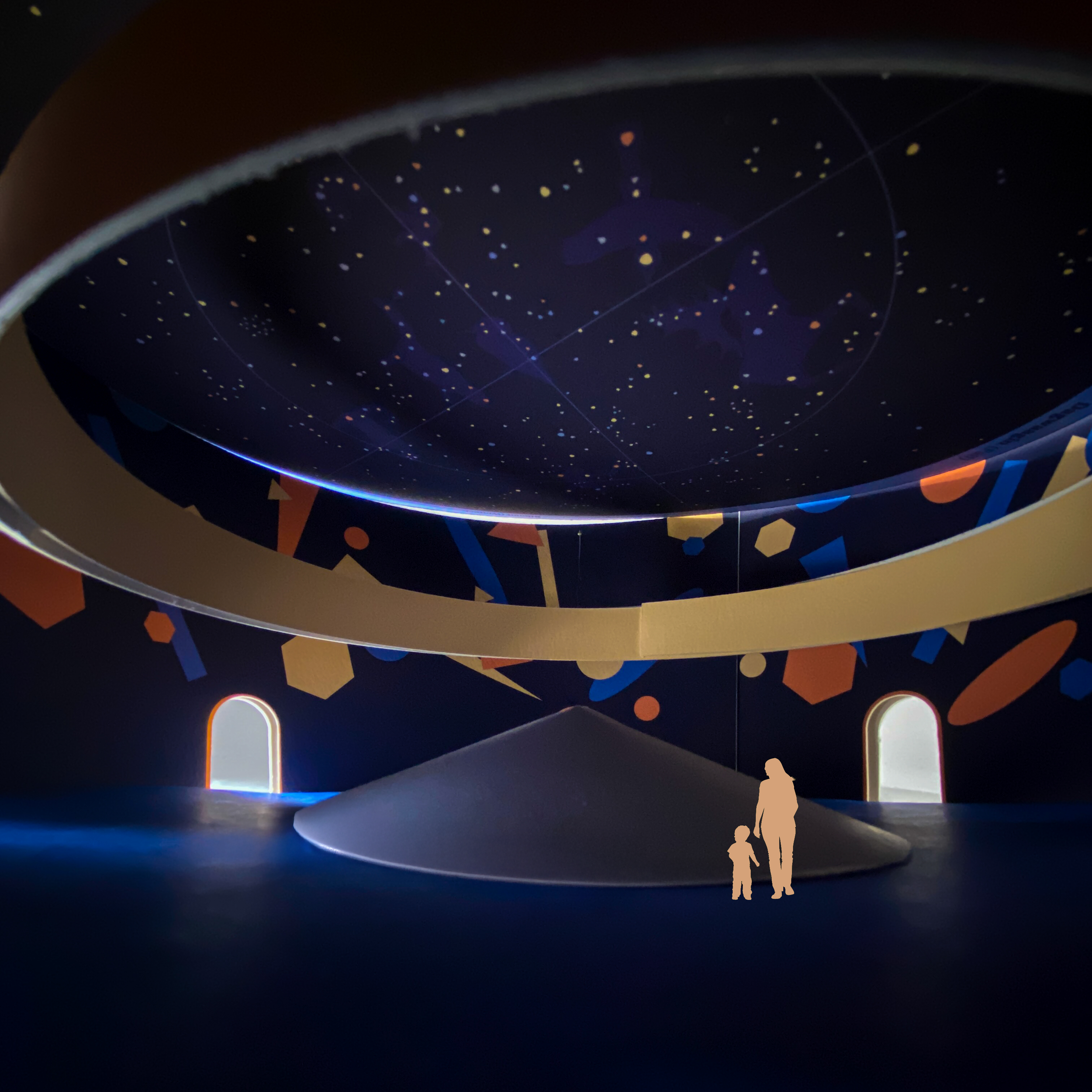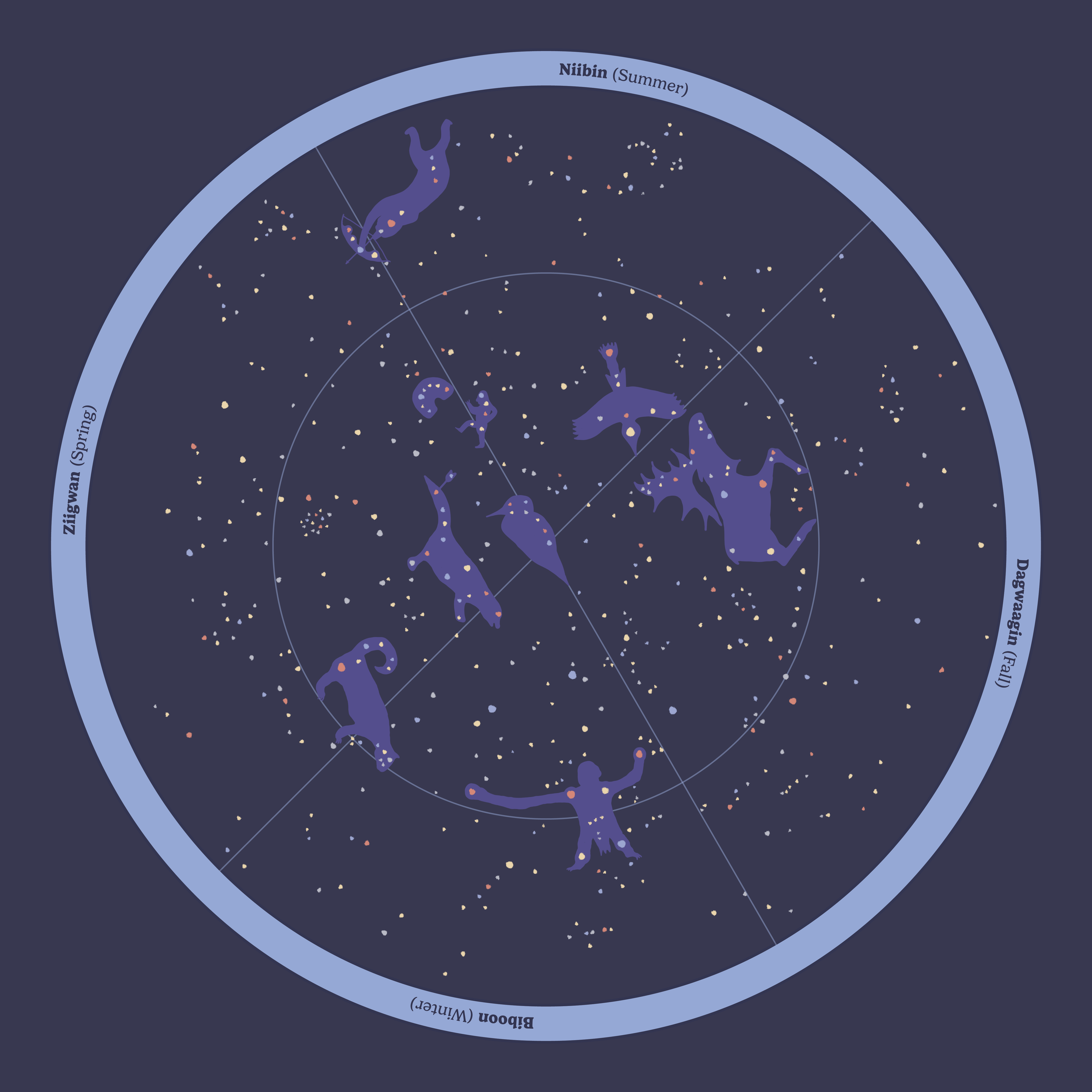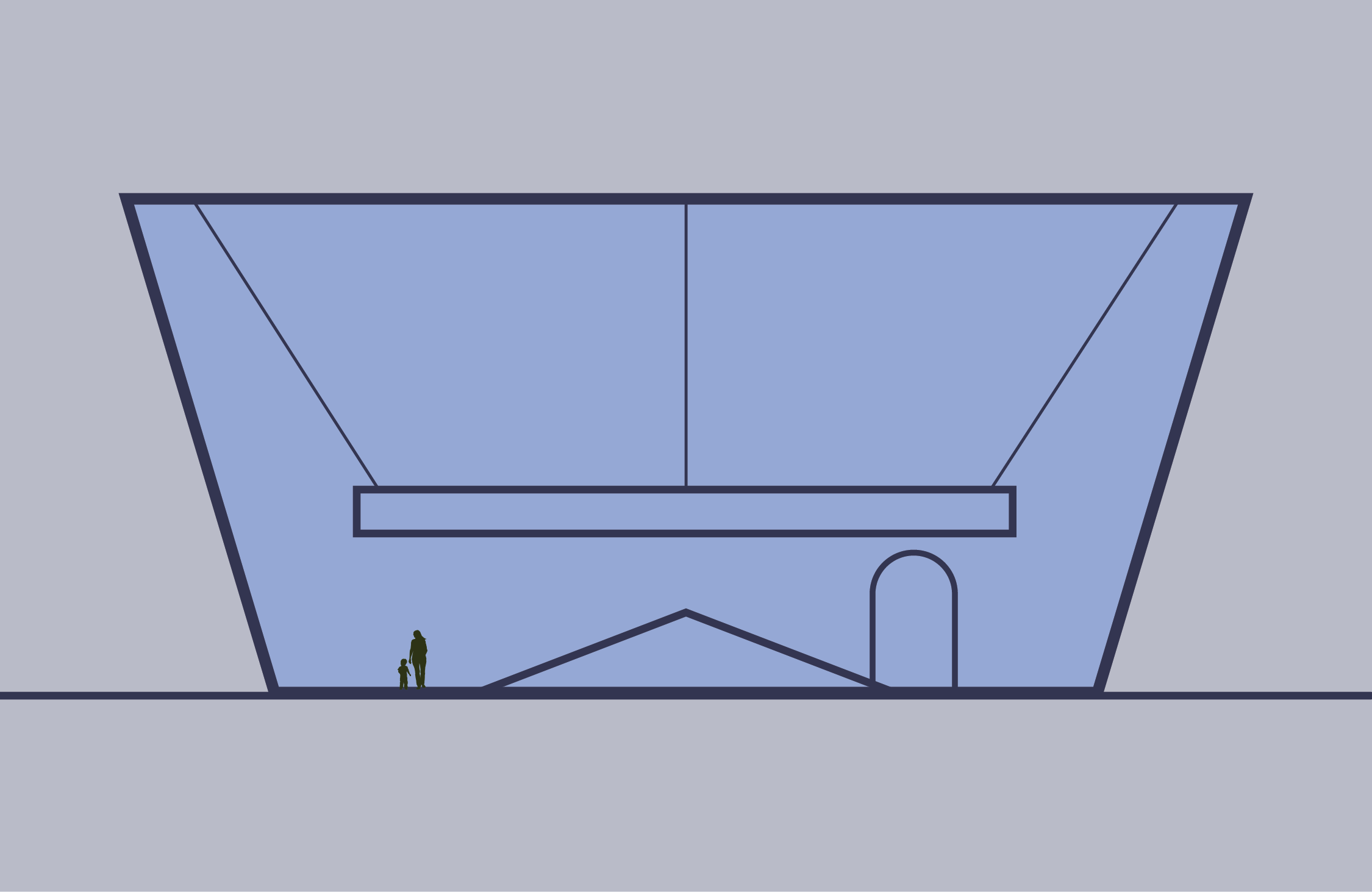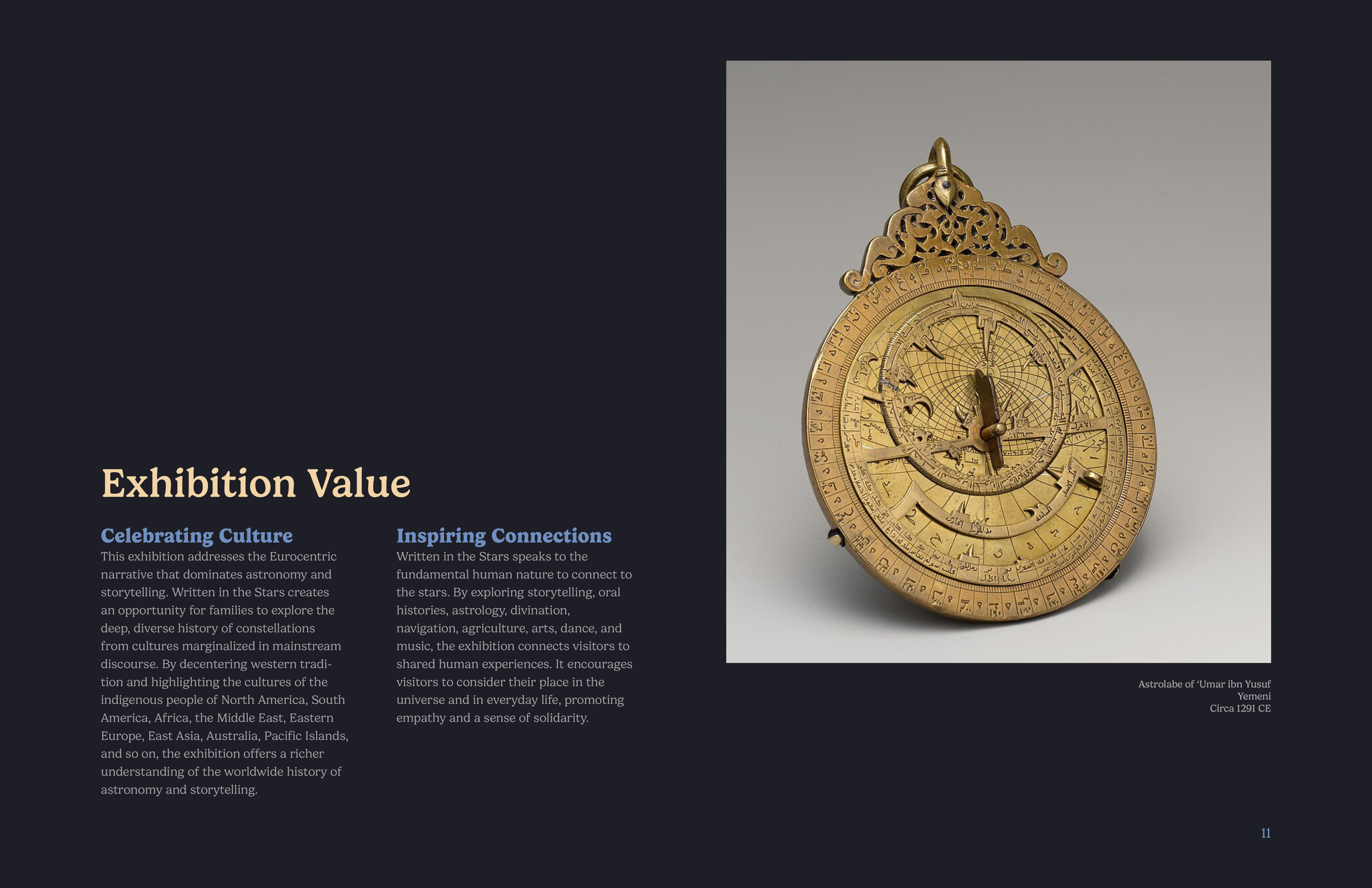
Designed for a children’s museum setting, this multi-media installation explores how people across the world have related to the stars throughout time. By challenging cultural colonialism and prompting empathy, this exhibit’s goal is to unify young people through shared experience and understanding.
Project Value
-
This exhibition addresses the Eurocentric narrative that dominates astronomy and storytelling. Written in the Stars creates an opportunity for families to explore the deep, diverse history of constellations from cultures marginalized in mainstream discourse. By decentering western tradition and highlighting other cultures with specific focus on indigenous groups of the Americas, the exhibition offers a richer understanding of the worldwide history of astronomy and storytelling.
-
Written in the Stars speaks to the fundamental human nature to connect to the stars. By exploring storytelling, oral histories, astrology, divination, navigation, agriculture, arts, dance, and music, the exhibition connects visitors to shared human experiences. It encourages visitors to consider their place in the universe and in everyday life, promoting empathy and a sense of solidarity.
-
With Montessori pedagogical principles at the forefront, interaction points and educational programming exist with a great depth of information that different age ranges can interact with at different levels. This allows for learners to build a relationship with the exhibition that grows and changes, revisit after revisit.
-
Educator-led programming, book readings, art classes, and other events held in the space allow Written in the Stars to function as a multi-use community education center.
Visual & Spatial Strategies
The exhibition brings new use to deeply culturally encoded aesthetics to engage the exhibition audience.
-
Graphic patterns inspired by 80s aesthetics draw subconscious connections to bowling alleys, arcades, and laser-tag arenas.
-
Soft colors in a primary palette convey a young audience while holding a subtle elegance. Inspired by Monet’s impressionism, the color palette skews warmer as it darkens, adding complexity and depth.
-
The main typeface of the exhibition is Gelica. As a retro serif typeface with rounded serifs, it bridges the gap between tradition and contemporary aesthetics. It speaks to history while adding a fun and human touch.
-
The qualities of outer space give inspiration to great contrasts that create varieties of spatial experiences implemented in the design-- dark vs. bright, quiet vs. loud, closed vs. open, small vs. big, low energy vs. high energy, close vs. far, slow vs. fast, and more.
-
Museum experiences can be overstimulating. By strategically distributing areas that are quieter, darker, and less crowded, a better experience is created for the sensory regulations of children and parents.
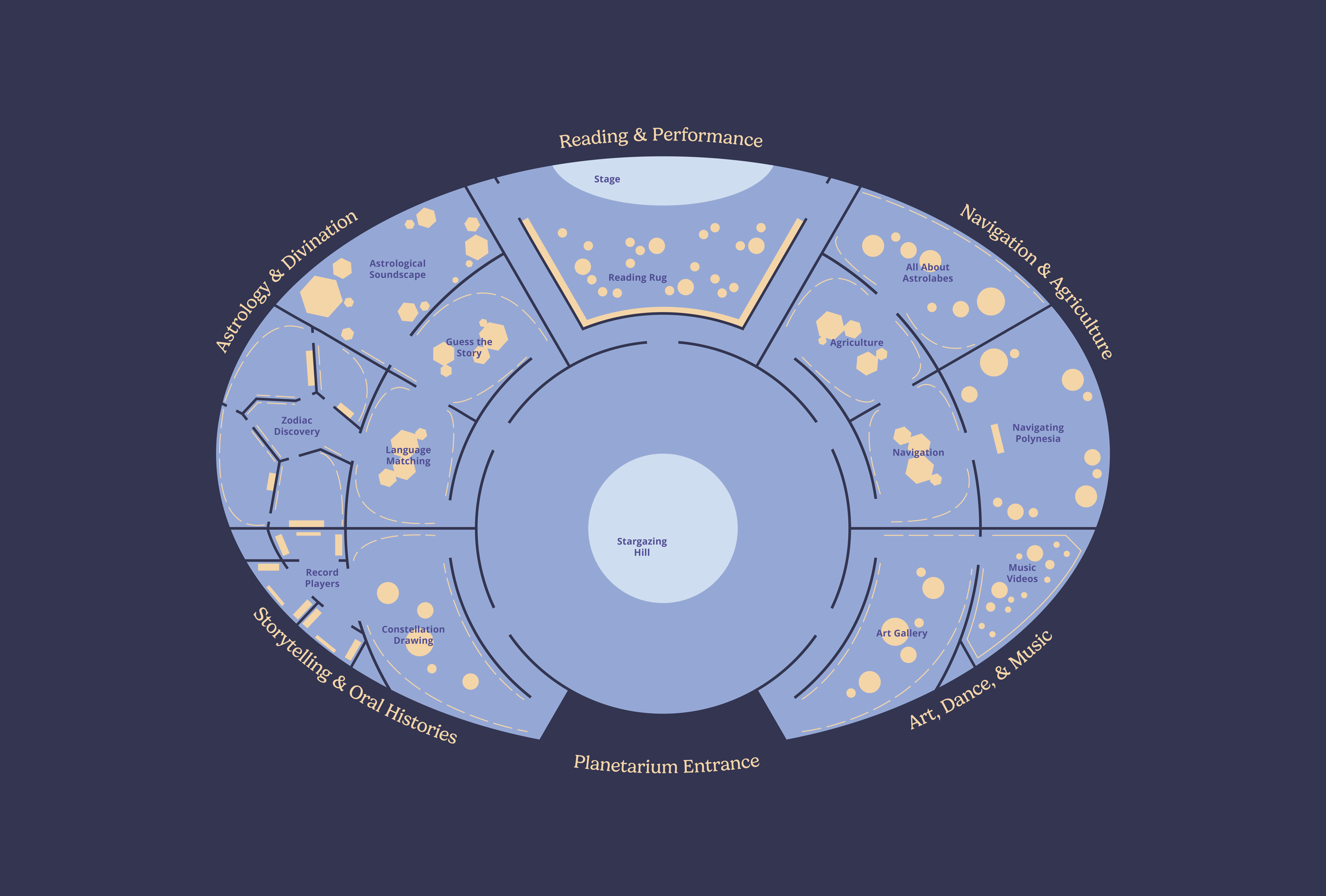
Discover the Exhibition
The Planetarium
This area of Written in the Stars functions as a main hub, inviting visitors to rest on a hill and look up at the stars.
-
A central engagement point is the hill, a giant conical form for visitors to lay down on and look up at the changing, projected constellations on the ceiling. The stars slowly turn to show the change of seasons, over time placing new constellations into focus. The projected show cycles through roughly 30 sky cultures-- sets of constellations as seen by different people across time.
-
The central planetarium acts as a hub, with the rest of the exhibition branching off from it. As people explore new aspects of culture in the different wings, they return to the main hub with a recontextualized understanding of the constellations on the ceiling. With the projections slowly changing, you’re sure to notice something different each time you revisit the planetarium.
Storytelling & Oral Histories
This area of Written in the Stars explores how people have used the stars to tell stories, creating and preserving culture.
-
This area features whiteboard tables with stars on them, inviting visitors to draw their own constellations. Children get to act as the astronomers and storytellers independent of historical context. Learners of all ages are able to be engaged by this activity at different levels.
-
Inspired by record players, this experience allows children to choose between different constellation map discs from a collection and place them on top of a lightboard, letting the constellations shine through. Placing the discs on the lightboard triggers recordings about the constellations to play. Each station has room for two discs, allowing learners to compare and contrast, building an understanding of cross-cultural connections.
Astrology & Divination
This area of Written in the Stars explores how people have used the stars to answer the unknown and find meaning in the universe.
-
In this area of the exhibition, children explore Babylonian (Western), Chinese, Hindu, and Mayan zodiac systems through a series of themed connecting rooms. Inspired by Brooklyn Children’s Museum’s World Brooklyn exhibition, the different areas set the stage for collaborative pretend play.
-
Through this matching game, children explore how astrology is deeply embedded in our language. Phrases like “coincidence” (when stars align), “disposition” (personality based on star position), and “mazal tov” (good alignment of the stars) reflect how often we unknowingly interact with ideas based in astrology.
-
In this activity, children use systems of astrology to create their own stories in a mad libs-style writing exercise. This activity makes writing approachable, makes concepts personal, and creates a keepsake from the exhibition experience.
-
This area of the exhibition features speakers throughout the room playing different noises that abstractly relate to different qualities of the zodiac. As the visitor moves through the room, different sounds overlap and change to reflect a changing of seasons and years.
Reading & Performance
This area of Written in the Stars functions as a community center. It holds a library and performance space.
-
This large reading and play area is a more relaxed space where parents can sit down while their young children play. Books and toys set the stage for play to occur in multiple directions.
-
During event times, the stage holds educational events such as book readings or puppetry shows. During off times, children are able to walk on stage and interact with the set and props themselves.
Navigation & Agriculture
This area of Written in the Stars explores how people have used the stars in practical ways, with constellations as an important science.
-
In this exhibition area, children are able to learn about the astrolabe and its importance. During educator-led event times, learners can craft their own astrolabes out of cardboard.
-
This exhibition area invites children to navigate between islands in the room by solving puzzles involving the constellations on the ceiling.
Art, Dance, & Music
This area of Written in the Stars explores how people of diverse backgrounds have been inspired by the stars to create art.
-
The art gallery holds contemporary art related to the stars, including art by local artists. A drawing area and display wall allows for children to draw and contribute their work to the gallery.
-
In this room, a supercut of music videos related to the stars plays. It acts as another more relaxed experience and engages both children and parents.
